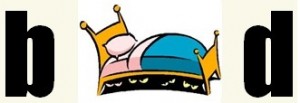Misreading the sounds “b” and “d” are common for emergent readers. Even when these youngsters write these sounds they are unable to correct their error unless they are taught specific strategies to differentiate between the two sounds and shapes of the letters. It is definitely not easy for some children to distinguish between “b” and “d” but some visual clues can be taught to assist children overcome this difficulty.
1) The most successful strategy I use is a visual representation of “b” and “d” using the idea of a bed. The “b” is placed on the left of the visual while the “d” is placed on the right. The middle section of the visual is as open ended as your imagination. Below are a couple of easy examples that can be pasted and copied onto paper and laminated for continued use.
 2) Another effective strategy for “b” is to introduce the sound as “b as in bee. Discuss how the word bee starts with “b” for bee and to remember its shape, think of a honeybee where the h can be closed at the bottom to become the shape of the letter “b”.
2) Another effective strategy for “b” is to introduce the sound as “b as in bee. Discuss how the word bee starts with “b” for bee and to remember its shape, think of a honeybee where the h can be closed at the bottom to become the shape of the letter “b”.
3) The “thumbs up strategy” is another effective way to develop young children’s perception of these letters. Ask children to make fists with both their hand, stick their thumbs up and join the fists together. Exlain that “b” comes before “d” in the alphabet and how this visual serves to remind young readers of this rule when writing “b” and “d”
You could also use this strategy with thumbs down for “p” and “q”
as well. The left hand makes the “p” and the right hand makes
the “q” as illustrated below.
4) The final strategy is to draw a capital “b” and show how easily this can be changed to a capital B. However remind children how it is not possible to do this with the capital letter D. This helps them to discern the differences when they are reading and writing.
Children perceive learning new concepts in different ways. Some are able to grasp the difference between “b” and “d” quite easily. Others will find this concept much more difficult to understand and will continue to confuse the two throughout their primary school years. The simple strategies presented in this article are tried and true and one of them or a combination of them will go some way to assisting emergent readers to differentiate between the letters before confusion becomes entrenched.
It is always important to follow up these concepts with appropriate activities to reinforce the new learning and assess for understanding. The following are a variety of short tasks to reinforce an understanding of these letters.
1) Brainstorm a list of words which start with “b” and repeat the same with “d”. Add visuals to these lists if possible.
2) Make a variety of words starting with “b” and “d” into cards and have children sort these cards into the correct categories. Choose a card at random and ask the child to say it in a sentence.
3) Play with the poetic device of alliteration and have children write short sentences. For example
Bob bought big black blueberries for Bess.
Dan ate delicious devon for dinner
Most of all allow your child/children to enjoy playing with these strategies early in their reading development. This way you will eleviate frustrations with reading and writing these letters in the future.




